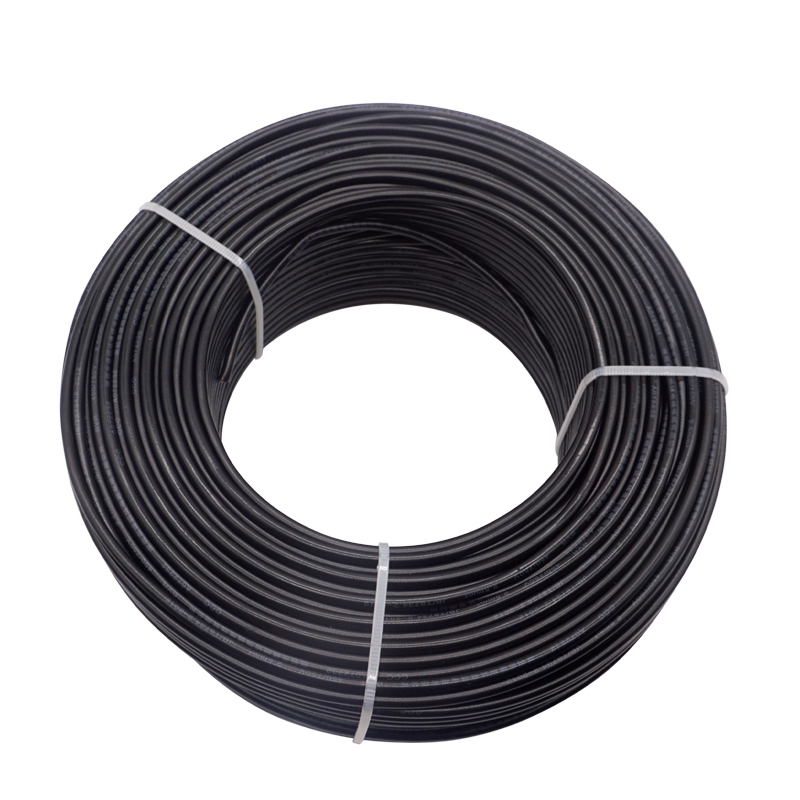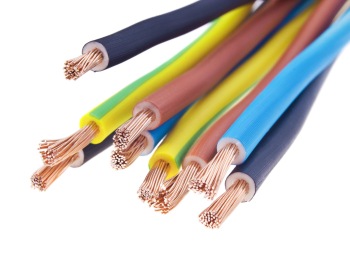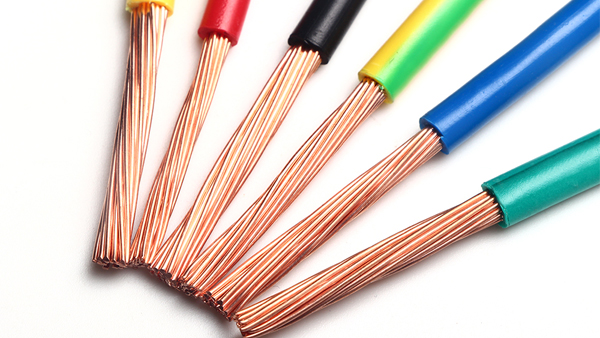 Author: Joey Wan
Author: Joey Wan  September 07,2022
September 07,2022
First, the definition of PVC cable
A cable is a wire product used to transmit electrical energy information and realize electromagnetic energy conversion. There are both conductors and insulating layers, and sometimes a tight inner sheath to prevent moisture intrusion, or an outer sheath with high mechanical strength. The structure is more complex and the product with a larger cross-sectional area is called a cable.

2. Classification of cables
Cables include power cables, control cables, compensation cables, shielded cables, high temperature cables, computer cables, signal cables, coaxial cables, fire-resistant cables, marine cables, mining cables, aluminum alloy cables and so on. They are all composed of single or multi-strand wires and insulating layers, which are used to connect circuits, appliances, etc.
According to the system of photovoltaic power station, cables can be divided into DC cables and AC cables, which are classified as follows according to different uses and use environments:
1. DC cable
(1) Serial cables between components.
(2) Parallel cables between the strings and between the strings and the DC distribution box (combiner box).
(3) The cable between the DC distribution box and the inverter.
The above cables are all DC cables, and there are many outdoor installations. They need to be moisture-proof, sun-proof, cold-resistant, heat-resistant, and UV-resistant. In some special environments, they also need to be protected from chemical substances such as acid and alkali.

2. AC cable
(1) The connecting cable from the inverter to the step-up transformer.
(2) The connecting cable from the step-up transformer to the power distribution device.
(3) The connecting cable from the power distribution device to the power grid or the user.
This part of the cable is an AC load cable, which is laid in the indoor environment and can be selected according to the general power cable selection requirements.
3. The model of the PVC cable
1. Composition and order
The model composition and sequence of wires and cables are as follows: [1: Category, use], [2: Conductor], [3: Insulation], [4: Inner sheath], [5: Structural features], [6: Outer sheath or derived], [7: Using features]
Items 1-5 and 7 are represented by pinyin letters, polymer materials are represented by the first letter of the English name, each item can be 1-2 letters; item 6 is 1-3 numbers.
2. Common code
Use code - not marked as power cable, K- (control cable), P- (signal cable);
Conductor material code - not marked as copper (can also be marked as CU), L- (aluminum);
Inner sheath code - Q- (lead clad), L- (aluminum clad), H- (rubber sheath), V- (polyvinyl chloride sheath), the inner sheath is generally not marked;
Outer sheath code - V- (polyvinyl chloride), Y- (polyethylene power cable);
Derivative code - D- (no drip), P- (dry insulation);
Special product code - TH- (wet tropical zone), TA- (dry tropical zone), ZR- (flame retardant), NH- (fire resistant), WDZ- (low smoke halogen free, enterprise standard).
3. The principle of omission
The principle of omission in the model: copper is the main conductor material used in wire and cable products, so the copper core code T is omitted, except for bare wires and bare conductor products. Bare wires and bare conductor products, power cables, and magnet wire products do not indicate the major category code, and electrical equipment wires and cables and communication cables are also not listed, but the subcategory or series code is listed.
Item 7 is a mark for various special use occasions or additional special use requirements, marked with pinyin letters after "-". Sometimes in order to highlight the item, this item is written to the front. Such as ZR- (flame retardant), NH- (fire resistance), WDZ- (low smoke and halogen free, enterprise standard), TH- (for use in humid and hot areas), FY- (termite prevention, enterprise standard), etc.
4. Main content
1) SYV: solid polyethylene insulated radio frequency coaxial cable, coaxial cable, radio frequency signal transmission in wireless communication, broadcasting, monitoring system engineering and related electronic equipment (including comprehensive coaxial cable)
2) SYWV (Y): Physically foamed polyethylene insulated cable TV system cable, video (RF) coaxial cable (SYV, SYWV, SYFV) is suitable for closed-circuit monitoring and cable TV projects
SYWV (Y), SYKV special cable structure for cable TV and broadband network: (coaxial cable) single oxygen-free round copper wire + physical foam polyethylene (insulation) + (tin wire + aluminum) + polyvinyl chloride (polyethylene )
3) Signal control cable (RVV sheathed wire, RVVP shielded wire) is suitable for building intercom, anti-theft alarm, fire protection, automatic meter reading and other projects

4) RG: Physically foamed polyethylene insulated access network cable for data analog signal transmission in coaxial optical fiber hybrid network (HFC)
5) KVVP: PVC sheathed braided shielded cable, application: signal transmission, control and measurement of electrical appliances, instruments and power distribution devices
6) RVV (227IEC52/53): PVC insulated flexible cable, use: household appliances, small power tools, instruments and power lighting
7) AVVR: PVC sheathed flexible cable for installation
8) SBVV: HYA data communication cable (indoor and outdoor) is used for the connection of telephone communication and radio equipment and the wiring of the junction box of the telephone distribution network
9) RV, RVP: PVC insulated cable
10) RVS, RVB: Suitable for connecting cables for household appliances, small power tools, instruments, meters and power lighting
11) BV, BVR: PVC insulated cable, use: suitable for fixed wiring of electrical instrumentation equipment and power lighting
12) RIB: speaker connection cable (fever cable)
13) KVV: PVC insulated control cable, application: signal transmission, control, measurement of electrical appliances, instruments, power distribution devices
14) SFTP: Twisted pair, transmission telephone, data and information network
15) UL2464: Computer cable
16) VGA: Monitor cable
17) SDFAVP, SDFAVVP, SYFPY: coaxial cable, dedicated for elevators
18) JVPV, JVPVP, JVVP: copper core PVC insulated and sheathed copper wire, braided electronic computer control cable
Fourth, the main purpose of the cable
Cables are mainly used for power supply; transmission and distribution; motor, electrical and electrical instrument windings to realize electromagnetic energy conversion; measurement of electrical and physical parameters; transmission of signals, information and control; for shared antenna TV or cable TV systems; Feeder lines for transmitting and receiving antennas of radio stations or connecting lines for various radio frequency communication and test equipment.
1. Electrical properties
Conductivity---Most products require good conductivity, and individual products require a certain resistance range.
Electrical insulation properties---insulation resistance, dielectric coefficient, dielectric loss, electrical resistance characteristics, etc.
Transmission characteristics---refers to high-frequency transmission characteristics, anti-interference characteristics, etc.
2. Aging performance
It refers to the ability of a product and its constituent materials to maintain their original properties under the action of mechanical stress, electrical stress, thermal stress and various other external factors, or under the action of external climatic conditions.
3. Thermal performance
Refers to the temperature resistance grade of the product, the heat generation and heat dissipation characteristics of the power transmission cable at the working temperature, the current carrying capacity, the short circuit and overload capacity, the thermal deformation and thermal shock resistance of the synthetic material, the thermal expansion of the material, and the dripping of the impregnated or coated material. drop performance, etc.
4. Corrosion resistance and weather resistance
Refers to galvanic corrosion resistance, biological and bacterial erosion resistance, chemical resistance (oil, acid, alkali, chemical solvent, etc.) erosion, salt spray resistance, light resistance, cold resistance, mildew resistance and moisture resistance.
5. Mechanical properties
Refers to tensile strength, elongation, bending, elasticity, flexibility, vibration resistance, abrasion resistance and mechanical impact resistance.

6. Other properties
Including the characteristics of some materials (such as hardness, creep of metal materials, compatibility of polymer materials) and some special use characteristics of products (such as non-flammability, atomic radiation resistance, insect bite, delayed transmission, and energy damping, etc.).
The performance requirements of cables are mainly put forward from the perspectives of the purpose of each classified cable, the conditions of use, and the matching relationship of supporting equipment. Among the various performance requirements of a product, some must be the main ones, play a decisive role, and should be strictly required. Some are subordinate. Sometimes certain factors restrict each other. Therefore, comprehensive research and analysis must be taken into consideration.
